Global Fruit of the Global World “Blueberries”
Blueberry is a species in the form of a perennial bush and is a berry in the Vaccinium genus of the Ericaceae family.
In the Black Sea region, two species, Vaccinium arctostaphylos (Ayı üzümü, Trabzon Çayı, Çay üzümü, Avcı üzümü, Likapa, Likarpa, Lifar) Vaccinium myrtillus (Çoban üzümü, Çalı, Highland likapa, Ground licorice) naturally grow. However, very small amounts of Vaccinium vitis idaea and Vaccinium uliginosum have also been reported.
[caption id="attachment_127943" align="aligncenter" width="442"]
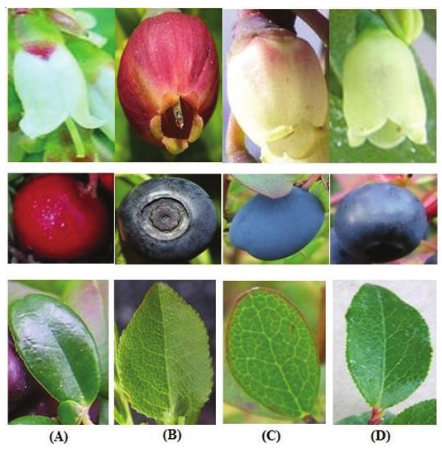 Figure 1:
Figure 1: Flowers, fruits and leaves of Vaccinium species that grow naturally in the Black Sea Region ((A) Vaccinium vitis idea L. (B) Vaccinium myrtillus L. (C) Vaccinium uliginosum L. (D) Vaccinium arctostaphylos L.).[/caption]
Due to the popularity of blueberries, which are native to America, the first selection processes were carried out by Dr. F.C. Coville in 1906. In European countries, the process of cultivating blueberries became the focus of attention in the early 20th
century when North America began to cultivate high bush blueberries.
The first plantation was established by Bergesius in 1923 in Assen, the Netherlands, on an area of 10 hectares. Dr. Piotr Hoser imported some blueberry plants to Poland in 1924. But these plants disappeared in the winter of 1929.
In the same year, German Dr. Walter Herrmann imported blueberry plants from America and began the process of cultivating and breeding these plants. Dr. Walter Herrmann, E. White and Dr. F.V. Coville continued to produce blueberry using seeds and hybrids from North America. Later, Dr. Heerma’s work continued as individually until 1934.
As a result of these studies, a plantation covering an area of 50 hectares was established in 1951. However, it was after the World War II that blueberries were noticed in the world market. Today, with the rapid development in forestry and agricultural technologies and the increase in the demand for functional foods, blueberries have become a sought-after product in the market.
Blueberry Varieties Commercially Produced in the World
While blueberries can grow naturally in the wild, many new varieties are cultivated as a result of breeding studies initiated in the 1900’s and mixed crossbreeding studies with some species and varieties belonging to these species.
Since blueberries are highly demanded products in the world market, breeding studies have been carried out to improve some of their characteristics such as harvesting season, yield, annual production intensity, fruit quality, resistance to diseases, and winter resistance. Many varieties that are subject to trade in the world have been bred from the following species. These are;
- 1. Lowbush blueberry (Vaccinium angustifolium).
2. Highbush blueberry (Vaccinium corymbosum). a) Northern highbush blueberries. b) Southern higbush blueberry.
3. Semi-Highbush blueberry (Vaccinium corymbosum X Vaccinium angustifolium).
4. Rabbiteye blueberry (Vaccinium ashei).
Although the blueberries that grow naturally in the forests and clearings in the Eastern Black Sea Region are consumed naturally by the local people, its importance is unknown to the people of the region and its consumption was continued only locally.
With the arrival of the first cultivars in the region in the 2000’s, adaptation trials were carried out, and it was determined that the Northern highbush blueberries were suitable for the region, and varieties generally obtained from these species were introduced.
However, in some regions, trials of southern highbsuh blueberries still continue. Personal and commercial production continues in the provinces of Artvin, Rize, Trabzon, Ordu, Giresun and Samsun in the Eastern Black Sea Region.
As with other blueberry species, the collection times of the Northern highbush blueberries showed difference after they reach full maturity. Although these collection times vary from region to region, with the effect of changing climatic conditions, they are generally called as follows;
Early Maturing Varieties; Varieties ripening at any time between June and July.
Mid-ripening Varieties; Varieties that mature in any time period from the second week of July to the beginning of August.
Mid-late Maturing Varieties; Varieties that mature at any time from mid-July to mid-
August. Late Maturing Varieties: Varieties that mature in any time period from August to the latest second week of September.
At the same time, fruit yields from varieties vary depending on climate and environmental conditions.
Lowbush Blueberry (Vaccinium Angustifolium)
As the name suggests, low-sized blueberry is a species that does not grow too tall, but rather spreads by forming rhizomes under the ground. It is very rarely slightly longer than 1.5 meters. Plants that have reached maturity may densely cover the above-ground surface.
This species is suitable for acidic soils with plenty of sunlight and good drainage. The soil should contain a high content of organic matter, but the amount of mineral matter that the plant can use may be low.
The soil pH required by this species is between 4.2 and 5.2. It is a very resistant species against acid rain. It is a species adapted to temperate climates.
Commercially cultivated varieties; Brunswick, London, Cumberland, Burgundy, Fundyy, Augusta, Claret, Jonesboro, North Country, Northsky, Pretty Yellow, Spring, Verde. Among these species, the varieties that are widely used industrially are Blomidon, Burgundy and Burnswick Highbush blueberry (Vaccinium Corymbosum).
[caption id="attachment_127944" align="aligncenter" width="554"]
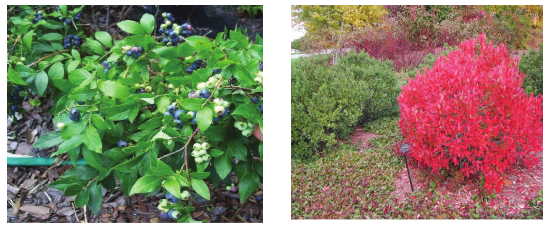
Figure 2: Lowbush blueberry fruit and general appearance[/caption]
Today, most of the varieties used in the blueberry plantation are included in these culture types. Highbush blueberries are suitable for both small-scale production and very large commercial production.
Highbush blueberries grow best in sandy clay soils with a pH between 4.5-5.0. It is vital that the soils where they grow are well drained, they need a lot of moisture, especially during the summer time.
The Highbush blueberries are divided into two parts among themselves. These are the northern and the southern origin blueberry species.
Northern highbush blueberries can grow up to 1.5 to 3 meters. It was planted for the first time in early 1920 with a species named “Rubel” selected from nature. Today, many species have been developed and continue to be developed. Northern blueberry species are verey productive species.
They have achieved a very good adaptation in mountainous areas. They are species that like cold regions. Although some sources write that temperatures below -20ºC can be tolerated by these species, some sources write that the plant may be damaged if the temperature drops below -30ºC in winter.
It is also resistant to many fruit diseases. As a result of the experimental studies, it was determined that the minimum cooling time required to increase the Northern highbush blueberries species was 800 hours.
There are more than 100 cultures of Northern highbush blueberries. In order to increase the yield of fruits to be planted commercially, it should be beneficial to plant more than one culture species in the area to be planted.
Some Northern highbush blueberries varieties that are subject to trade; Earliblue, Bluecrop, Bluegold, Torro, Jersey, Brigitta, Bluejay, Aurora, Bluetta, Blueray, Chandler, Coville, Collins, Croatan, Darrow, Draper, Duke, Echota, Elliott, Hardyblue, Ivanhoe, Lateblue, Liberty, Nelson, Northland, Nui, Olympia, Patriot, Reka, Rubel, Spartan.
[caption id="attachment_127945" align="aligncenter" width="640"]
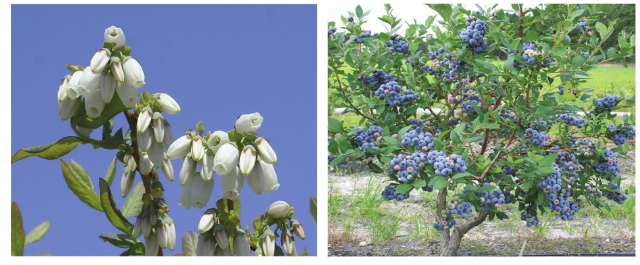
Figure 3: Northern highbush blueberries flower and fruit[/caption]
Southern higbush blueberry species are heat-loving and intolerant to extreme winter conditions. Chilling needs are quite low, an average of 200-300 hours of chilling time is sufficient for these species.
These species can grow up to 2-4 meters. Cultivation of this species is a little troublesome compared to other species. Some species mature quite early, even in April mature species have been reported.
However, it is quite resistant to frosts that may occur in the spring. It is suitable for low organic content soil.
Some southern higbush blueberry varieties that are subject to trade; Oneil, Sharpblue, Jubile, Ozarkblue, Misty, Snowchaser, Primadonna, Springhigh, Jewel, Rebel, Sapphire, Millennia, Star, Abudance, Windsor, Southern Belle, Emerald, Palmetto, Camellia, Santa Fe, Bladen, Bluecrisp, Reveillei Pamlico, Lenoir, Craven, Marimba, Southmoon, Avonblue, Gulfcoast, Georgian, Cooper, Sampson, Biloxi, Capefear, Flordablue, Magnolia, Blueridge, Pearl River, Summit, Legacy.
[caption id="attachment_127946" align="aligncenter" width="681"]
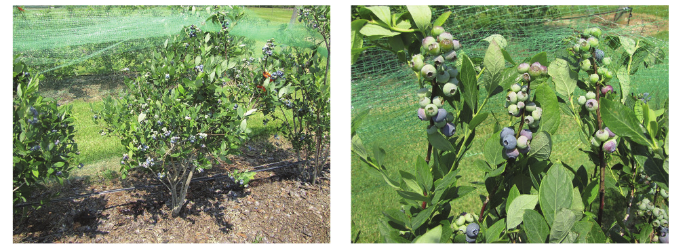
Figure 4: Southern higbush blueberry general appearance and fruit (Gumbo variety)[/caption]
Semi-highbush blueberry varieties are generally obtained by crossing Highbush blueberry blueberries with Lowbush blueberry (V. corymbosum x V. angustifolium). Semi highbush blueberry are resistant to extreme winter temperatures.
While the northern species can suffer serious damage when the temperature drops below -30ºC, the Semi-highbush blueberry species can tolerate temperatures between -37 and -43ºC. However, they may not be as productive as northern types.
Since the yields of some species are low or moderate, they are not preferred in areas where commercial plantations are made, if highbush blueberry can be grown. However, this does not mean that they are not commercially produced.
Commercial production is carried out intensively in cold regions. Some commercially available Semi-highbush blueberry varieties are Tophat, Northsky, Chippewa, Northblue, Polaris, Northcountry and Friendship.
[caption id="attachment_127947" align="aligncenter" width="670"]

Figure 5: Semi-highbush blueberry general appearance and fruit (Top Hat variety)[/caption]
Rabbiteye Blueberry (Vaccinium Ashei)
Cultivation of this species began in the 1940’s. They are not suitable for cultivation in mountainous areas, since they bloom early.
Chilling times are between 450-600 hours. Compared to the Northern highbush blueberries, it has less tolerance to cold. These species grow in a wide variety of acidic soils and soils with low organic matter (1-2%). However, it is a very weak frost-resistant species. Another problem is that it is a self-inefficient species.
This necessitates pollination with other rabbit-eyed blueberry species. For this reason, Rabbiteye Blueberry varieties that are compatible with each other in the regions where this species will be cultivated should be determined and planted together to facilitate pollination.
Some of the rabbit-eyed blueberry trials established in areas with drought problems yielded interesting results. Some commercially available Rabbiteye Blueberry varieties;
Powderblue, Ochlockonee, Tifblue, Yadkin, Baldwin, Alapaha, Climax, Premier, Montgomery, Ira, Brightwell, Onslow, Windy, Snowflake, Savory, Beckyblue, Aliceblue, Vernon, Bonita, Bluegem, Woodard, Chaucer, Bluebelle, Briteblue, Choice, Columbus, Delite, Centurion.
[caption id="attachment_127948" align="aligncenter" width="731"]
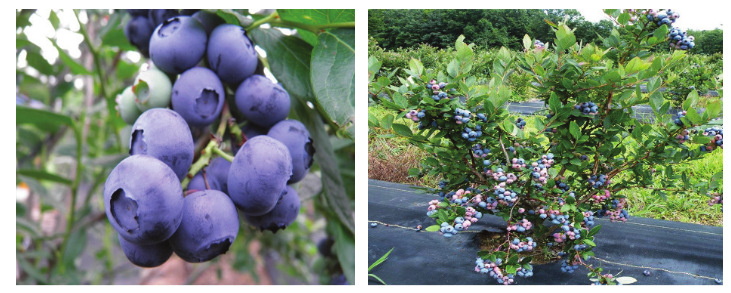
Figure 6: Rabbit-eyed blueberry general appearance and fruit (Desoto variety)[/caption]
Medicinal and Chemical Properties of Blueberries
Bioactive components in blueberries cause the products obtained from these fruits to have medicinal and biological properties. Extracts from blueberries have been reported to have many pharmacological activities.
Some of these are wound healing properties, anti-ulcer, anti-atherosclerotic and vasoprotective effects. It is also very effective in regulating the body's circulatory system. Anthocyanins in blueberries increase the permeability and elasticity of the capillaries in the eyeball, so it improves night vision by increasing microcirculation.
Thanks to these properties, extracts obtained from blueberries are used in the preparation of eye-related preparations. Apart from these, it has been stated that some Vaccinium species have antidiabetic properties.
These species are widely used in traditional medicine in the treatment of diabetic patients. The effect of many plant extracts on longevity has been studied on C. elegans. It was observed that the extract obtained from the V. angustifolium plant extended the average lifespan of C. elegans by 28%. The presence of flavonoid, phenolic acid, Vitamin C, Vitamin E, carotenoids and various minerals in the composition of Blueberries make these fruits a rich source of antioxidants.
Its low calorie and sodium content and its high fiber source make this plant one of the most important nutrients. The therapeutic role of Blueberries are due to the phenolic compounds in its structure.
Therefore, the type of fruit and the cultivation conditions of the plant have an important effect on the formation of this type of chemical composition in the fruit.
Referances Chambers, B. ve Camire, M., 2003. Can cranberry supplementation benefit adults with type II diabetes? Diabetes Care 26, 2695–2696. Connor, A.M., Luby, J.J., Tong, C.B.S., Finn, C.E. ve Hancock, J.F., 2002. Genotypic and enviromental variation in antioxidant activity, total phenolic content and anthociyanin content among bluberry cultivars, Journal of the American Society for Horticultural Science, 127, 1, 89-97. Çelik, H., 2011. Samsun İçin Yeni ve Popüler Üzümsü Meyveler: Maviyemiş ve Turnayemişi, Mart, Samsun Sempozyumu, Bildiriler Kitabı: 1-9. Çelik, H., Özgen, M. ve Saraçoğlu, O., 2012. Organik ve Standart Olarak Yetiştirilen Bazı Yüksek Boylu Maviyemiş (Vaccinium corymbosum L.) Çeşitlerinin Fitokimyasal İçerikleri ile Antioksidan Kapasitelerinin Karşılaştırılması, Tarım Bilimleri Dergisi, 16, 167-176. Davis, P.H., 1978. Flora of Turkey and East Aegean Islands, Edinburg Univ. Press, 6, 89- 108. Gao, G. ve Draper, E., 2010. Growing Blueberries in the Home Garden, Agriculture and Natural Resources, Fact Sheet,1-8. İpek, A., Sertkaya, İ., Gedikli, M., Ceylan, Ö.S., Genç, H.E., Akbulut, M., Baykal, H. ve Şavşatlı, Y., 2014. Ayıüzümü (Vaccinium arctostaphylos L.) türünün envanterine ait bir araştırma: Trabzon Orman Bölge Müdürlüğü Örneği, Journal of Forestry Research, 1, 1, 60-67. Jellin, J.M., Gregory, P.J., Batz, F. ve Hitchens, K., 2005. Natural medicines comprehensive database. In: Pharmacist’s Letter/Prescriber’s Letter. Therapeutic Research Faculty, Stockton, CA, 2239. Kafkas, E., Özgen, M., Özoğul, Y., ve Türemış, N., 2008. Phytochemıcal and fatty acid profile of selected red raspberry cultivars: A Comparatıve Study, Journal of Food Quality, 31, 67-78. Koca, I. ve Karadeniz, B., 2009. Antioxidant properties of blackberry and blueberry fruits grown in the Black Sea Region of Turkey, 121, 447-450. Lord, W., 2013. Wild New Hampshire Blueberries, Cooperative Extension, Universty of New Hampshire, 1-4. Özyağci, M.A., Dengiz, O. ve Aydoğan, M., 2013. Çay Yetiştirilen Tarım Topraklarının Reaksiyon Değişimleri ve Alansal Dağılımları, Toprak-Su Dergisi, 2, 1,
Plattner, K., Fonsah, E.G., Escalante, C., Krewer, G., Scherm, H., Andersen, P.C., Liburd, O., ve Teruliano, M., 2008. Economics of Organic Blueberry Establishment in Georgia, Journal of Food Distribution Research, 39, 1, 111-115. Pliszka, K.,1997. Overview on Vaccinium Production In Europe, Acta Horticulture (ISHS), 446, 49-52. Powell, A., Dozier W.A. ve Himelrick, D.G., 2002. Commercial Blueberry Production Guide for Alabama, Alabama Cooperative Extension System, Auburn Universities, ANR-904, 1-15. Sciarappa, W.J., 2005. Selecting Blueberry Varieties for the Home Garden, New Jersey Agricultural Experiment Station, Rutgers Cooperative Research and Extension, Fact Sheet, FS419, 1-3. Sellappan, S., Akoh, C. ve Krewer, G., 2002. Phenolic compounds and antioxidant capacity of Georgia-grown blueberries and blackberries, Journal of Agricultural Food Chemistry, 50, 2432-2438. Shorthouse, J.D. ve Bagatto, G., 1995. Potential Role of Lowbush Blueberry (Vaccinium angustifolium) in Colonizing Metal-Contaminated Ecosystems. In: Restoration and Recovery of an Industrial Region, John M. Gunn (eds.). Springer Series on Environmental Management. 247-255. Šne, E., Kampuse, S. ve Berna, E., 2009. The Composition of Sugar and Sugar-Acid Ratio of Highbush Blueberry Varieties Grown in Lativa, Food Science, 140144.
Sowers, R., 2011. Blueberries, Making a Superb Fruit Even Better, Agricultural Research, May-June, 1-8. Strik, B.C. ve Finn, C.E., 2008. Blueberry Cultivars For Oregon, Oregon State University, Extension Service, Oregon, USA, 1-12. URL-1,http://erdogan.edu.tr/maviyemis/?page_id=26. 15.12.2014. Wilson, M.A., Shukitt-Hale, B., Kalt, W., Ingram, D.K., Joseph, J.A. ve Wolkow, C.A., 2006. Blueberry polyphenols increase lifespan and thermotolerance in Caenorhabditis elegans. Aging Cell. 5, 59-68. Zee, F., Hummer, K., Nishijima, W., Kai, R., Strauss, A., Yamasaki, M. ve Hamasaki, R.T., 2006. Preliminary Yields of Southern Highbush Blueberry in Waimea, Hawai‘i, Fruits and Nuts, 12, 1-8.
[caption id="attachment_127950" align="alignnone" width="293"]

Asst. Prof. Dr. Onur Tolga Okan Karadeniz Technical University Macka Vocational School Department of Chemistry and Chemical Process Technology[/caption]

 Figure 1: Flowers, fruits and leaves of Vaccinium species that grow naturally in the Black Sea Region ((A) Vaccinium vitis idea L. (B) Vaccinium myrtillus L. (C) Vaccinium uliginosum L. (D) Vaccinium arctostaphylos L.).[/caption]
Due to the popularity of blueberries, which are native to America, the first selection processes were carried out by Dr. F.C. Coville in 1906. In European countries, the process of cultivating blueberries became the focus of attention in the early 20th
century when North America began to cultivate high bush blueberries.
The first plantation was established by Bergesius in 1923 in Assen, the Netherlands, on an area of 10 hectares. Dr. Piotr Hoser imported some blueberry plants to Poland in 1924. But these plants disappeared in the winter of 1929.
In the same year, German Dr. Walter Herrmann imported blueberry plants from America and began the process of cultivating and breeding these plants. Dr. Walter Herrmann, E. White and Dr. F.V. Coville continued to produce blueberry using seeds and hybrids from North America. Later, Dr. Heerma’s work continued as individually until 1934.
As a result of these studies, a plantation covering an area of 50 hectares was established in 1951. However, it was after the World War II that blueberries were noticed in the world market. Today, with the rapid development in forestry and agricultural technologies and the increase in the demand for functional foods, blueberries have become a sought-after product in the market.
Figure 1: Flowers, fruits and leaves of Vaccinium species that grow naturally in the Black Sea Region ((A) Vaccinium vitis idea L. (B) Vaccinium myrtillus L. (C) Vaccinium uliginosum L. (D) Vaccinium arctostaphylos L.).[/caption]
Due to the popularity of blueberries, which are native to America, the first selection processes were carried out by Dr. F.C. Coville in 1906. In European countries, the process of cultivating blueberries became the focus of attention in the early 20th
century when North America began to cultivate high bush blueberries.
The first plantation was established by Bergesius in 1923 in Assen, the Netherlands, on an area of 10 hectares. Dr. Piotr Hoser imported some blueberry plants to Poland in 1924. But these plants disappeared in the winter of 1929.
In the same year, German Dr. Walter Herrmann imported blueberry plants from America and began the process of cultivating and breeding these plants. Dr. Walter Herrmann, E. White and Dr. F.V. Coville continued to produce blueberry using seeds and hybrids from North America. Later, Dr. Heerma’s work continued as individually until 1934.
As a result of these studies, a plantation covering an area of 50 hectares was established in 1951. However, it was after the World War II that blueberries were noticed in the world market. Today, with the rapid development in forestry and agricultural technologies and the increase in the demand for functional foods, blueberries have become a sought-after product in the market.
 Figure 2: Lowbush blueberry fruit and general appearance[/caption]
Today, most of the varieties used in the blueberry plantation are included in these culture types. Highbush blueberries are suitable for both small-scale production and very large commercial production.
Highbush blueberries grow best in sandy clay soils with a pH between 4.5-5.0. It is vital that the soils where they grow are well drained, they need a lot of moisture, especially during the summer time.
The Highbush blueberries are divided into two parts among themselves. These are the northern and the southern origin blueberry species.
Northern highbush blueberries can grow up to 1.5 to 3 meters. It was planted for the first time in early 1920 with a species named “Rubel” selected from nature. Today, many species have been developed and continue to be developed. Northern blueberry species are verey productive species.
They have achieved a very good adaptation in mountainous areas. They are species that like cold regions. Although some sources write that temperatures below -20ºC can be tolerated by these species, some sources write that the plant may be damaged if the temperature drops below -30ºC in winter.
It is also resistant to many fruit diseases. As a result of the experimental studies, it was determined that the minimum cooling time required to increase the Northern highbush blueberries species was 800 hours.
There are more than 100 cultures of Northern highbush blueberries. In order to increase the yield of fruits to be planted commercially, it should be beneficial to plant more than one culture species in the area to be planted.
Some Northern highbush blueberries varieties that are subject to trade; Earliblue, Bluecrop, Bluegold, Torro, Jersey, Brigitta, Bluejay, Aurora, Bluetta, Blueray, Chandler, Coville, Collins, Croatan, Darrow, Draper, Duke, Echota, Elliott, Hardyblue, Ivanhoe, Lateblue, Liberty, Nelson, Northland, Nui, Olympia, Patriot, Reka, Rubel, Spartan.
[caption id="attachment_127945" align="aligncenter" width="640"]
Figure 2: Lowbush blueberry fruit and general appearance[/caption]
Today, most of the varieties used in the blueberry plantation are included in these culture types. Highbush blueberries are suitable for both small-scale production and very large commercial production.
Highbush blueberries grow best in sandy clay soils with a pH between 4.5-5.0. It is vital that the soils where they grow are well drained, they need a lot of moisture, especially during the summer time.
The Highbush blueberries are divided into two parts among themselves. These are the northern and the southern origin blueberry species.
Northern highbush blueberries can grow up to 1.5 to 3 meters. It was planted for the first time in early 1920 with a species named “Rubel” selected from nature. Today, many species have been developed and continue to be developed. Northern blueberry species are verey productive species.
They have achieved a very good adaptation in mountainous areas. They are species that like cold regions. Although some sources write that temperatures below -20ºC can be tolerated by these species, some sources write that the plant may be damaged if the temperature drops below -30ºC in winter.
It is also resistant to many fruit diseases. As a result of the experimental studies, it was determined that the minimum cooling time required to increase the Northern highbush blueberries species was 800 hours.
There are more than 100 cultures of Northern highbush blueberries. In order to increase the yield of fruits to be planted commercially, it should be beneficial to plant more than one culture species in the area to be planted.
Some Northern highbush blueberries varieties that are subject to trade; Earliblue, Bluecrop, Bluegold, Torro, Jersey, Brigitta, Bluejay, Aurora, Bluetta, Blueray, Chandler, Coville, Collins, Croatan, Darrow, Draper, Duke, Echota, Elliott, Hardyblue, Ivanhoe, Lateblue, Liberty, Nelson, Northland, Nui, Olympia, Patriot, Reka, Rubel, Spartan.
[caption id="attachment_127945" align="aligncenter" width="640"] Figure 3: Northern highbush blueberries flower and fruit[/caption]
Southern higbush blueberry species are heat-loving and intolerant to extreme winter conditions. Chilling needs are quite low, an average of 200-300 hours of chilling time is sufficient for these species.
These species can grow up to 2-4 meters. Cultivation of this species is a little troublesome compared to other species. Some species mature quite early, even in April mature species have been reported.
However, it is quite resistant to frosts that may occur in the spring. It is suitable for low organic content soil.
Some southern higbush blueberry varieties that are subject to trade; Oneil, Sharpblue, Jubile, Ozarkblue, Misty, Snowchaser, Primadonna, Springhigh, Jewel, Rebel, Sapphire, Millennia, Star, Abudance, Windsor, Southern Belle, Emerald, Palmetto, Camellia, Santa Fe, Bladen, Bluecrisp, Reveillei Pamlico, Lenoir, Craven, Marimba, Southmoon, Avonblue, Gulfcoast, Georgian, Cooper, Sampson, Biloxi, Capefear, Flordablue, Magnolia, Blueridge, Pearl River, Summit, Legacy.
[caption id="attachment_127946" align="aligncenter" width="681"]
Figure 3: Northern highbush blueberries flower and fruit[/caption]
Southern higbush blueberry species are heat-loving and intolerant to extreme winter conditions. Chilling needs are quite low, an average of 200-300 hours of chilling time is sufficient for these species.
These species can grow up to 2-4 meters. Cultivation of this species is a little troublesome compared to other species. Some species mature quite early, even in April mature species have been reported.
However, it is quite resistant to frosts that may occur in the spring. It is suitable for low organic content soil.
Some southern higbush blueberry varieties that are subject to trade; Oneil, Sharpblue, Jubile, Ozarkblue, Misty, Snowchaser, Primadonna, Springhigh, Jewel, Rebel, Sapphire, Millennia, Star, Abudance, Windsor, Southern Belle, Emerald, Palmetto, Camellia, Santa Fe, Bladen, Bluecrisp, Reveillei Pamlico, Lenoir, Craven, Marimba, Southmoon, Avonblue, Gulfcoast, Georgian, Cooper, Sampson, Biloxi, Capefear, Flordablue, Magnolia, Blueridge, Pearl River, Summit, Legacy.
[caption id="attachment_127946" align="aligncenter" width="681"] Figure 4: Southern higbush blueberry general appearance and fruit (Gumbo variety)[/caption]
Semi-highbush blueberry varieties are generally obtained by crossing Highbush blueberry blueberries with Lowbush blueberry (V. corymbosum x V. angustifolium). Semi highbush blueberry are resistant to extreme winter temperatures.
While the northern species can suffer serious damage when the temperature drops below -30ºC, the Semi-highbush blueberry species can tolerate temperatures between -37 and -43ºC. However, they may not be as productive as northern types.
Since the yields of some species are low or moderate, they are not preferred in areas where commercial plantations are made, if highbush blueberry can be grown. However, this does not mean that they are not commercially produced.
Commercial production is carried out intensively in cold regions. Some commercially available Semi-highbush blueberry varieties are Tophat, Northsky, Chippewa, Northblue, Polaris, Northcountry and Friendship.
[caption id="attachment_127947" align="aligncenter" width="670"]
Figure 4: Southern higbush blueberry general appearance and fruit (Gumbo variety)[/caption]
Semi-highbush blueberry varieties are generally obtained by crossing Highbush blueberry blueberries with Lowbush blueberry (V. corymbosum x V. angustifolium). Semi highbush blueberry are resistant to extreme winter temperatures.
While the northern species can suffer serious damage when the temperature drops below -30ºC, the Semi-highbush blueberry species can tolerate temperatures between -37 and -43ºC. However, they may not be as productive as northern types.
Since the yields of some species are low or moderate, they are not preferred in areas where commercial plantations are made, if highbush blueberry can be grown. However, this does not mean that they are not commercially produced.
Commercial production is carried out intensively in cold regions. Some commercially available Semi-highbush blueberry varieties are Tophat, Northsky, Chippewa, Northblue, Polaris, Northcountry and Friendship.
[caption id="attachment_127947" align="aligncenter" width="670"] Figure 5: Semi-highbush blueberry general appearance and fruit (Top Hat variety)[/caption]
Figure 5: Semi-highbush blueberry general appearance and fruit (Top Hat variety)[/caption]
 Figure 6: Rabbit-eyed blueberry general appearance and fruit (Desoto variety)[/caption]
Figure 6: Rabbit-eyed blueberry general appearance and fruit (Desoto variety)[/caption]
 Asst. Prof. Dr. Onur Tolga Okan Karadeniz Technical University Macka Vocational School Department of Chemistry and Chemical Process Technology[/caption]
Asst. Prof. Dr. Onur Tolga Okan Karadeniz Technical University Macka Vocational School Department of Chemistry and Chemical Process Technology[/caption]